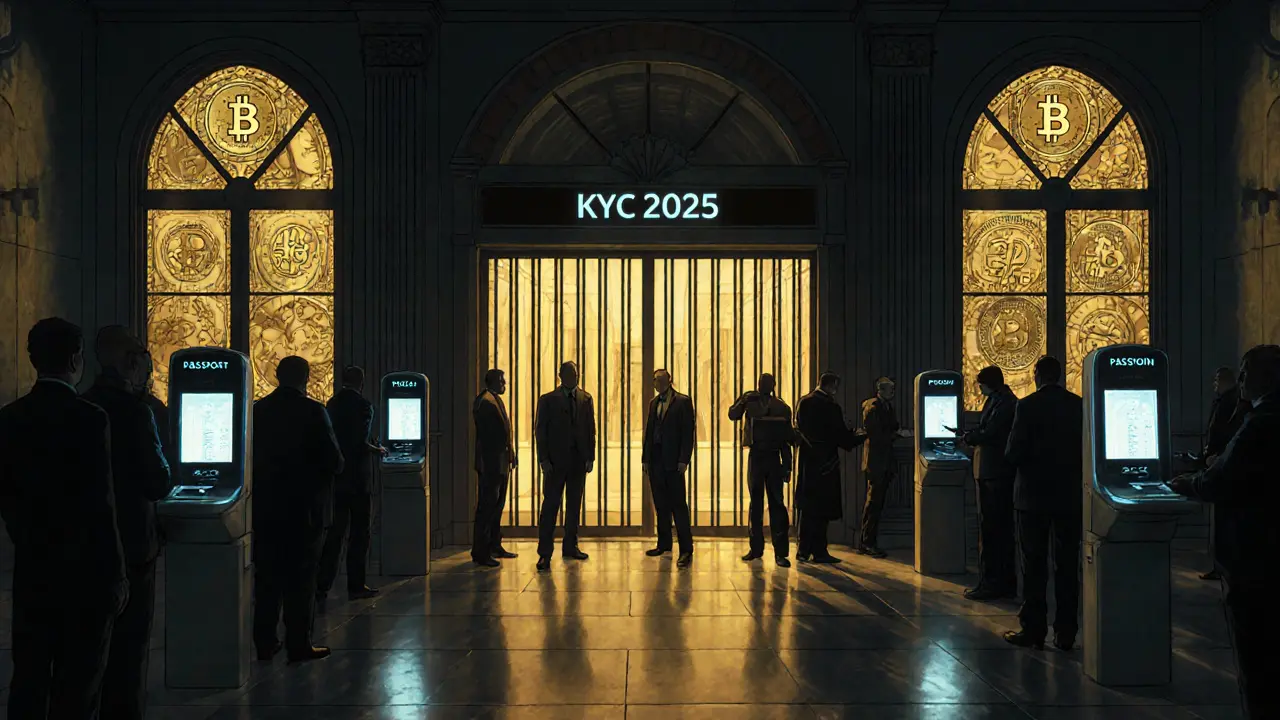KYC Cost Calculator for Crypto Exchanges
Estimate Your KYC Compliance Costs
Calculate annual KYC costs based on your exchange's size, features, and international presence. Based on industry data from 2025.
By 2025, if you want to trade crypto on any major platform, you must go through KYC. It’s no longer a checkbox-it’s the gatekeeper. What started as a loose suggestion from regulators has become the backbone of the entire crypto industry. Without it, exchanges get shut down. Without it, banks refuse to process crypto deposits. Without it, you can’t even buy Bitcoin on Coinbase, Binance, or Kraken anymore. And it’s not slowing down. In fact, it’s getting tighter, smarter, and more invasive.
KYC Is Now Non-Negotiable Infrastructure
In 2019, the Financial Action Task Force (FATF) made it clear: crypto exchanges are financial institutions. That meant they had to follow the same rules as banks-verify who you are, track where your money comes from, and report suspicious activity. Fast forward to 2025, and 92% of centralized exchanges globally enforce full KYC. That’s not a choice anymore. It’s the law. And it’s working-at least from a compliance standpoint. In 2025 alone, over 1,200 crypto wallets linked to sanctioned entities were flagged by AML systems. That’s up 32% from the year before. The goal isn’t to spy on you. It’s to keep criminals out. Money launderers, ransomware operators, and fraudsters rely on anonymity. KYC breaks that anonymity. And it’s not just about ID cards anymore. Modern systems use AI to cross-check your face with government databases in under four minutes. They scan your documents for tampering. They analyze your transaction history across blockchains. They even check if you’ve been flagged by global watchlists-over 1,700 of them, updated in real time.How It Works Today: The Step-by-Step Reality
If you’ve ever signed up for a crypto exchange, you’ve seen this flow:- Upload a photo of your passport or driver’s license.
- Take a live selfie to match your ID.
- Submit a recent utility bill or bank statement as proof of address.
- Answer questions about where your money came from-especially if you’re depositing over $10,000.
- Wait. Sometimes it takes seconds. Sometimes it takes days.
Centralized vs. Decentralized: The Great Divide
This is where things get interesting. Centralized exchanges (CEXs) like Binance and Coinbase? Fully locked down. KYC is mandatory. No exceptions. Decentralized exchanges (DEXs)? Most still don’t require it. Less than 15% of DEXs do any real identity checks. That’s because they’re built on code, not compliance teams. You connect your wallet, swap tokens, and walk away-no ID, no paperwork. But here’s the problem: the FATF Travel Rule applies to transactions over $100,000. That means if you send $120,000 from a CEX to a DEX, the CEX has to send your identity data to the receiving platform. If the DEX doesn’t collect that data? The CEX can’t send it. So, you’re blocked. And that’s exactly what’s happening. More and more users are finding their funds stuck because the DEX won’t comply. Some DEXs are trying to adapt. A few are experimenting with zero-knowledge proofs-tech that proves you’re not a criminal without revealing your name. But it’s early. And regulators aren’t convinced. They want to see your face, your address, your source of funds. Until they do, DEXs will remain on the fringes for large transactions.
The Hidden Cost: Privacy, False Flags, and User Frustration
Let’s be honest. Most people don’t like KYC. Not because they’re hiding anything. But because they’re tired of handing over personal data to companies with questionable privacy policies. A 2025 survey of 3,500 crypto users found that 76% want clear explanations about how their data is stored and used. Only 41% got them. That’s a huge trust gap. Reddit threads are full of users who closed accounts after being asked for bank statements from 2019 or getting flagged for a small transfer from a friend’s wallet. False positives are a real problem. If you bought crypto on a platform that later got flagged for money laundering, your wallet might get tagged-even if you did nothing wrong. That means your funds could be frozen for weeks while you prove you’re clean. Shufti Pro’s own data shows 63% of negative reviews cite this issue. And then there’s the cost. For a mid-sized exchange, running KYC costs around $185,000 a year. That’s not just software. It’s lawyers, compliance officers, customer support teams handling appeals. That’s why smaller platforms either skip KYC entirely-or get crushed by regulators. The top five KYC tech providers (Sumsub, Shufti Pro, Onfido, Jumio, Trulioo) now control 68% of the market. It’s becoming a monopoly.What’s Next: The Future of KYC by 2027
The future isn’t about more paperwork. It’s about smarter systems. First, continuous KYC is coming. Instead of verifying you once and forgetting, platforms will monitor your behavior constantly. If you suddenly start sending large amounts to high-risk wallets? You’ll get asked for more info. If you’re a long-term user with clean history? You might get fewer checks. Second, CBDCs (Central Bank Digital Currencies) will embed KYC at the wallet level. If you get a digital dollar from the Federal Reserve, your identity will be tied to it from day one. That means even if you move crypto to a DEX, if it’s linked to a CBDC, your identity travels with it. Third, zero-knowledge proofs could be the game-changer. Imagine proving you’re over 18, not from a sanctioned country, and not on a watchlist-without showing your name, address, or ID. That’s possible today with ZKPs. The World Economic Forum predicts this will be mainstream by 2027. But regulators are skeptical. Can you audit something you can’t see? That’s the debate. Finally, mandatory reporting kicks in in 2026. In the U.S., every crypto transaction over $10 will require KYC data to be reported on a new 1099-DA form. That means exchanges will have to track every swap, every staking reward, every NFT sale. And send it to the IRS.
Can You Avoid KYC? The Reality Check
Some still try. Bitcoin ATMs. Peer-to-peer trades. Privacy coins like Monero. But here’s the truth: these options are shrinking fast. Chainalysis data shows less than 12% of total crypto trading volume happens without KYC. And that number is falling. Banks are cutting off services to non-KYC platforms. Payment processors like Stripe and PayPal won’t touch them. Even decentralized apps are starting to integrate KYC-because users need to cash out eventually. You can’t avoid KYC forever. The only question is: do you want to do it on your terms, with a transparent provider, or get caught in a compliance trap later?Final Thoughts: Compliance Is the New Normal
The crypto industry isn’t going back to the wild west. The regulators won’t allow it. The banks won’t allow it. The users, even the privacy-focused ones, are starting to accept it-because they want to use crypto without getting locked out. KYC isn’t perfect. It’s slow sometimes. It’s invasive. It’s expensive. But it’s working. Crime rates in crypto are dropping. Fraud is being caught. Legitimate users are getting faster access because the bad actors are being filtered out. The future belongs to platforms that balance security with simplicity. That means AI that works fast, clear privacy policies, and systems that give users control-not just compliance officers. If you’re using crypto in 2025, you’re already in the new system. The only thing left to do is understand it, protect your data, and move forward.Is KYC mandatory for all crypto exchanges in 2025?
Yes, for centralized exchanges (CEXs), KYC is mandatory in 92% of cases globally. Major platforms like Coinbase, Binance, and Kraken require full identity verification. Decentralized exchanges (DEXs) mostly still don’t enforce KYC, but they’re increasingly blocked by regulatory pressure and banking restrictions, especially for large transactions.
How long does crypto KYC take in 2025?
On top platforms like Shufti Pro and Sumsub, most verifications complete in under 8 seconds for standard users. For high-risk cases-large deposits, unusual activity, or international documents-it can take up to 48 hours. The average across all exchanges is now 3.5 minutes, down from over 15 minutes in 2022.
What documents do I need for crypto KYC?
You’ll typically need: a government-issued photo ID (passport or driver’s license), a proof of address (utility bill or bank statement dated within the last 90 days), and sometimes a selfie for biometric matching. For large deposits or high-risk users, you may also need source-of-funds documentation, like pay stubs or bank statements showing where the money came from.
Can I use crypto without KYC in 2025?
Technically, yes-but it’s extremely limited. You can still use Bitcoin ATMs, peer-to-peer trades, or DEXs without KYC. But these methods account for less than 12% of total trading volume. Most banks won’t process deposits from non-KYC platforms, and cashing out to fiat becomes nearly impossible. Your options shrink the more you use crypto.
Why do I keep getting flagged during KYC?
False positives happen when your transaction history or wallet is linked to a flagged address-even if you didn’t do anything wrong. This can occur if you received crypto from a hacked wallet, bought from a peer who later got sanctioned, or used a platform that was later blacklisted. The system flags the address, not you. You’ll need to submit documentation proving your innocence, which can take days or weeks.
Will zero-knowledge proofs replace traditional KYC?
Not replace-but enhance. Zero-knowledge proofs allow you to prove you meet compliance requirements (like being over 18 or not on a sanctions list) without revealing your identity. By 2027, this tech could become standard for privacy-focused verification. But regulators still want audit trails. So expect hybrid systems: ZKPs for daily use, with traditional KYC as a backup for high-risk cases.
How much does KYC cost crypto exchanges?
For a mid-sized exchange processing $10M-$50M monthly volume, annual KYC costs average $185,000. This includes software licenses, compliance staff, legal fees, and customer support for verification appeals. Larger exchanges pay over $1 million annually. The top five KYC tech providers (Sumsub, Shufti Pro, Onfido, Jumio, Trulioo) control 68% of the market, making competition limited and pricing high.

Eli PINEDA
November 1, 2025 AT 20:44Genevieve Rachal
November 3, 2025 AT 08:41Debby Ananda
November 4, 2025 AT 10:22Ron Cassel
November 4, 2025 AT 23:27Jeremy Jaramillo
November 5, 2025 AT 04:05Nadiya Edwards
November 6, 2025 AT 09:29Vicki Fletcher
November 6, 2025 AT 10:36bob marley
November 8, 2025 AT 10:17naveen kumar
November 9, 2025 AT 09:31ISAH Isah
November 10, 2025 AT 15:46Sammy Krigs
November 11, 2025 AT 07:18